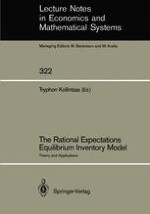This volume consists of six essays that develop and/or apply "rational expectations equilibrium inventory models" to study the time series behavior of production, sales, prices, and inventories at the industry level. By "rational expectations equilibrium inventory model" I mean the extension of the inventory model of Holt, Modigliani, Muth, and Simon (1960) to account for: (i) discounting, (ii) infinite horizon planning, (iii) observed and unobserved by the "econometrician" stochastic shocks in the production, factor adjustment, storage, and backorders management processes of firms, as well as in the demand they face for their products; and (iv) rational expectations. As is well known according to the Holt et al. model firms hold inventories in order to: (a) smooth production, (b) smooth production changes, and (c) avoid stockouts. Following the work of Zabel (1972), Maccini (1976), Reagan (1982), and Reagan and Weitzman (1982), Blinder (1982) laid the foundations of the rational expectations equilibrium inventory model. To the three reasons for holding inventories in the model of Holt et al. was added (d) optimal pricing. Moreover, the popular "accelerator" or "partial adjustment" inventory behavior equation of Lovell (1961) received its microfoundations and thus overcame the "Lucas critique of econometric modelling.
